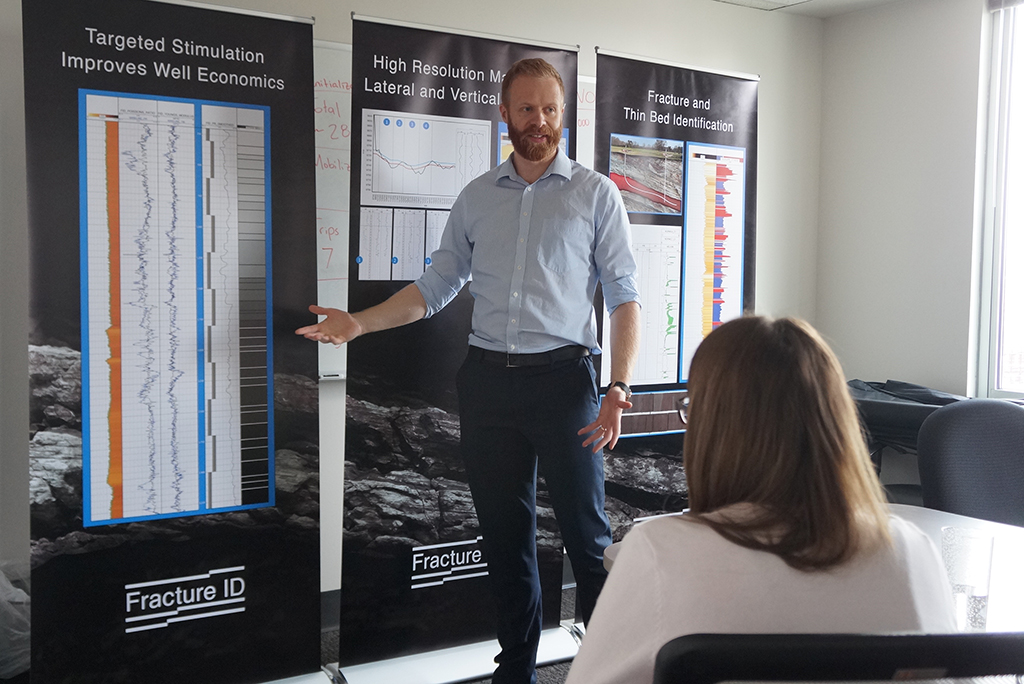
Josh Ulla, director of business development at Fracture ID, presenting to a group of the startup’s employees. (Amy DiPierro)
With $2 million pumped into its strongbox, a Denver-based startup is fueling its fracking technology.
Fracture ID records the vibrations as oil and gas operators drill wells, data its says customers can use to learn about surrounding rock formations and to boost oil and gas production per well.
The startup has raised $2 million as of July 25, according to an SEC filing. And the company announced in a press release on Friday that venture capital firm Energy Innovation Capital is an investor.
Fracture ID president Chris Neale said the company is looking to hire more employees and to develop its technology so that customers can monitor the rock around each well in more detail as they drill.
“We can hire some more people to help us around (technology development), to really increase our sales and marketing efforts and to develop a custom-acquisition tool,” said Neale. “We’re looking at a higher resolution tool and a real-time tool.”
To fracture rock, oil and gas operators insert a pipe with small perforations into a well and inject it with fluid. The pressurized fluid fractures the rock when it escapes through the perforations.
For a given type of rock, a well design creates the most fractures at the lowest cost. But because operators space pipe perforations at regular intervals, a single perforation might fracture different types of rock.
Neale said oil and gas operators are starting to realize that spacing perforations to fracture one type of rock at a time could incrementally increase their production in every well.
“What we’re trying to do is help them to target those perforations,” said Neale. “For the same amount of fluid that you’re pumping, you can create more fractures and you should produce more oil.”
Traditionally, to learn about the rock surrounding a hydrocarbon deposit, oil and gas companies have measured how quickly sound waves travel through rock or how much radioactivity they emit.
Fracture ID takes a different approach. It records how the drill bit vibrates as it drills through the rock.
Neale said that method is more accurate and more economical. The instrument used to measure vibration is cheaper than the tools to collect sound data and (unlike recording sound data, which usually requires operators to pause drilling), Fracture ID’s method saves time by recording data in the midst of drilling.
The company has monitored 35 wells with 11 different customers since 2015 and projects that it will monitor as many as 90 wells this year.
Fracture ID charges customers by the well. Price depends on the length of the well and drill time. Generally, taking measurements for a 5,000-foot well costs $30,000 and a 10,000-foot well costs $45,000 to $50,000. Neale said most wells cost oil and gas operators between $6 million and $10 million total to drill and complete.
Josh Ulla, the company’s director of business development, called this summer “the perfect storm” for Fracture ID: oil prices and rig counts are rebounding, just as Fracture ID’s product is hitting the market.
“We’re just at the point now where it’s just going to be everywhere,” said Ulla.
The company has three positions open on its website. Ulla said he would like to hire a sales team in Houston and possibly Denver soon, too.

Josh Ulla, director of business development at Fracture ID, presenting to a group of the startup’s employees. (Amy DiPierro)
With $2 million pumped into its strongbox, a Denver-based startup is fueling its fracking technology.
Fracture ID records the vibrations as oil and gas operators drill wells, data its says customers can use to learn about surrounding rock formations and to boost oil and gas production per well.
The startup has raised $2 million as of July 25, according to an SEC filing. And the company announced in a press release on Friday that venture capital firm Energy Innovation Capital is an investor.
Fracture ID president Chris Neale said the company is looking to hire more employees and to develop its technology so that customers can monitor the rock around each well in more detail as they drill.
“We can hire some more people to help us around (technology development), to really increase our sales and marketing efforts and to develop a custom-acquisition tool,” said Neale. “We’re looking at a higher resolution tool and a real-time tool.”
To fracture rock, oil and gas operators insert a pipe with small perforations into a well and inject it with fluid. The pressurized fluid fractures the rock when it escapes through the perforations.
For a given type of rock, a well design creates the most fractures at the lowest cost. But because operators space pipe perforations at regular intervals, a single perforation might fracture different types of rock.
Neale said oil and gas operators are starting to realize that spacing perforations to fracture one type of rock at a time could incrementally increase their production in every well.
“What we’re trying to do is help them to target those perforations,” said Neale. “For the same amount of fluid that you’re pumping, you can create more fractures and you should produce more oil.”
Traditionally, to learn about the rock surrounding a hydrocarbon deposit, oil and gas companies have measured how quickly sound waves travel through rock or how much radioactivity they emit.
Fracture ID takes a different approach. It records how the drill bit vibrates as it drills through the rock.
Neale said that method is more accurate and more economical. The instrument used to measure vibration is cheaper than the tools to collect sound data and (unlike recording sound data, which usually requires operators to pause drilling), Fracture ID’s method saves time by recording data in the midst of drilling.
The company has monitored 35 wells with 11 different customers since 2015 and projects that it will monitor as many as 90 wells this year.
Fracture ID charges customers by the well. Price depends on the length of the well and drill time. Generally, taking measurements for a 5,000-foot well costs $30,000 and a 10,000-foot well costs $45,000 to $50,000. Neale said most wells cost oil and gas operators between $6 million and $10 million total to drill and complete.
Josh Ulla, the company’s director of business development, called this summer “the perfect storm” for Fracture ID: oil prices and rig counts are rebounding, just as Fracture ID’s product is hitting the market.
“We’re just at the point now where it’s just going to be everywhere,” said Ulla.
The company has three positions open on its website. Ulla said he would like to hire a sales team in Houston and possibly Denver soon, too.


Leave a Reply